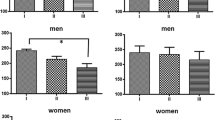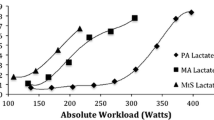Summary
Subjects exercised in the upright position at approximately 50% of maximal oxygen consumption in four situations: in 25‡ C air, in 45‡ C air [mean skin temperature (\(\bar T\) sk) 35‡ C], in 35‡ C water immersed to the level of the xiphoid process, and finally wearing a suit perfused with 35‡ C water. The water immersion prevented gravitational shifts of blood volume to the legs. In this situation the forearm blood flow (FBF) rose continually with increasing core temperature (Tes) in contrast to the attenuation in rise above 38‡ C Tes in 45‡ C air. The differences were significant above 38.6‡ C Tes in experiments in eight subjects. The effects of immersion on cardiac output (CO), stroke volume (SV), and heart rate (HR) were studied in five of the subjects in relation to Tes, since the rate of rise of Tes was different in the four situations. CO and SV tended to be higher during both rest and exercise in the water than in the other three conditions, while HR rose in the same manner with increasing core temperature, except that it was lower in 25‡ C air, where Tes was lower. Thus, the prevention of hydrostatic shifts of peripheral venous volume permitted the maintenance of a higher SV and peripheral blood flow, and enhanced the ability of the circulation to deal with the combined exercise and heat stress.
Similar content being viewed by others
References
åstrand P-O, Englesson S (1972) A swimming flume. J Appl Physiol 33: 514
Arborelius M, Balldin UI, Lilja B, Lundgren CFG (1972) Hemodynamic changes in man during immersion with the head above water. Aerospace Med 43: 592–598
Bonde-Petersen F, Norsk P, Suzuki Y (1980) A comparison between freon and acetylene rebreathing for measuring cardiac output. Aviat Space Environ Med 51: 1214–1221
Brengelmann GL, Johnson JM, Hermansen L, Rowell LB (1977) Altered control of skin blood flow during exercise at high internal temperatures. J Appl Physiol/Respir Environ Exerc Physiol 43: 790–794
Gauer OH, Thron HL (1965) Postural changes in the circulation. In: Hamilton WF, Dow P (eds) Handbook of physiology. Circulation, vol III, chapt 67: 2409–2439, Washington, DC [Am Physiol Soc, sect 2] pp 2409–2439
Henry JP (1951) The significance of the loss of blood volume into the limbs during pressure breathing. Aviat Med 22: 31–38
Henry JP, Gauer OH (1950) The influence of temperature upon venous pressure in the foot. J Clin Invest 29: 855–861
Johnson JM (1979) Responses of forearm blood flow to graded leg exercise in man. J Appl Physiol: Respir Environ Exerc Physiol 46: 457–462
Johnson JM, Park MK (1979) Reflex control of skin blood flow by skin temperature: Role of core temperature. J Appl Physiol/Respir Environ Exerc Physiol 47: 1188–1193
Johnson JM, Rowell LB, Brengelmann GL (1974) Modifications of the skin blood flow body temperature relationship by upright exercise. J Appl Physiol 37: 880–886
Nadel ER, Stolwijk JAJ (1973) Effect of skin wettedness on sweat gland response. J Appl Physiol 35: 689–694
Nadel ER, Cafarelli E, Roberts MF, Wenger CB (1979) Circulatory regulation during exercise in different ambient temperatures. J Appl Physiol: Respir Environ Exerc Physiol 46: 430–437
Nadel ER, Fortney SM, Wenger CB (1980) Effect of hydration state on circulatory and thermal regulations. J Appl Physiol: Respir Environ Exerc Physiol 49: 715–721
Nielsen B, Nielsen M (1965) On the regulation of sweat secretion in exercise. Acta Physiol Scand 64: 314–322
Risch WD, Konbenec HJ, Bechmann U, Lange S, Gauer OH (1978) The effect of graded immersion on heart volume, central venous pressure, pulmonary blood flow distribution and heart rate in man. Pflügers Arch 374: 115–118
Rowell LB, Marx HJ, Bruce RA, Conn RD, Kusumi F (1966) Reductions in cardiac output, central blood volume, and stroke volume with thermal stress in normal men during exercise. J Clin Invest 45: 1801–1816
Rowell LB, Murray JA, Brengelmann GL, Kraning KK (1969) Human cardiovascular adjustments to rapid changes in skin temperature in exercising man. Circ Res 24: 711–724
Triebwasser JH, Johnson RL, Burpo RP, Cambell JC, Reardon WC, Blomqvist G (1977) Noninvasive determination of cardiac output by a modified acetylene rebreathing procedure utilizing Mass Spectrometer measurements. Aviat Space Environ Med 48: 203–209
Whitney R (1953) The measurement of volume changes in human limbs. J Physiol [Lond] 121: 1–27
Author information
Authors and Affiliations
Additional information
Supported by the Danish Space Board (1112-32/81), the Danish Medical Research Council (512–15983), and the Danish Sports Research Council. Dr. Rowell was supported in part by NHLBI Grant HL 16910
Rights and permissions
About this article
Cite this article
Nielsen, B., Rowell, L.B. & Bonde-Petersen, F. Cardiovascular responses to heat stress and blood volume displacements during exercise in man. Europ. J. Appl. Physiol. 52, 370–374 (1984). https://doi.org/10.1007/BF00943365
Accepted:
Issue Date:
DOI: https://doi.org/10.1007/BF00943365




